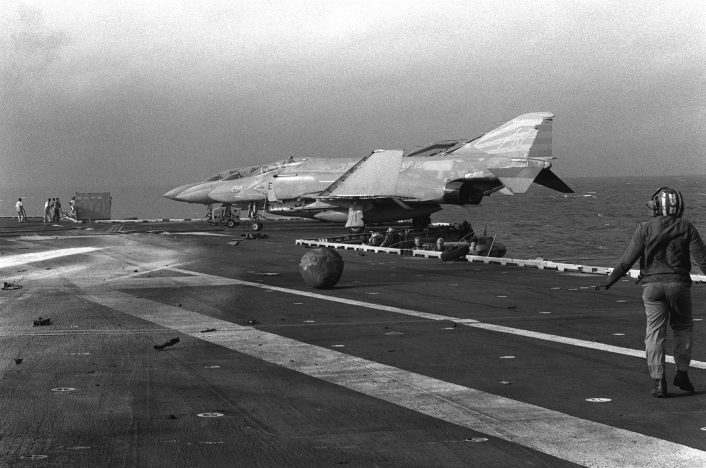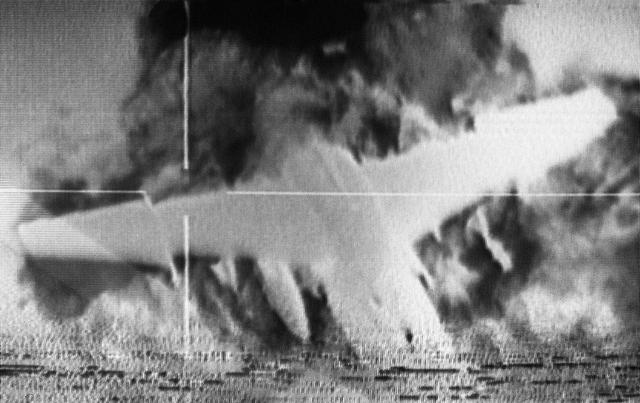Pitching decks can make a carrier trap landings extremely dangerous….
The video in this post was filmed aboard USS Midway on Aug. 21, 1984. It shows U.S. Navy A-7E Corsair II (BuNo 157495) belonging to VA-56 “Champions” bursting into flames after a ramp strike on 21 August 1984. The pilot, Lt. Thomas R. Doyle, 24, was killed in the incident. The incident occurred in the East China Sea, despite a wave off due to a pitching deck.
Several images of the incident have been available online for years. Some of these have become quite popular and show the moments after the Corsair hits the ramp and burst into flames.

Others show the aftermath of the incident.

The clip has recently been posted online. It was filmed by the Pilot’s Landing Aid Television (PLAT) camera used by Landing Signal Officers (LSO) to monitor approaching aircraft position on the glideslope and centerline.
You can clearly hear the LSO shouting “Wave it off” multiple times, instructing the pilot to abort the trap landing.
Here’s another version of the same video, with no audio, but without the large watermark:
LSO talkdown is available to pilots as they approach the aircraft carrier for a trap landing. Here’s a brief explanation included in a past article published here at The Aviationist:
From the last three quarters of a mile all the way to touchdown the pilots approaching an aircraft carrier can rely on LSO (radio callsign “Paddles”), skilled and experienced pilots whose job is to watch the deck-landing of all the aircraft and provide the pilots talkdown to adjust the final phase of the approach, complementing IFLOLS (Improved Fresnel Lens Optical Landing System) and ICLS (Instrumental Carrier Landing System) visual information. Instructions radioed to the pilots (that are extremely important to prevent the pilot from concentrating on the deck, thus not paying as much attention to the optical landing system) are concise: “Little low”, “Little right”, “Power”, “Wave off”, etc. “Paddles” job has very little to do with technology though and it mostly calls for a well-trained eye for the concise guidelines pilots are provided with over the radio are based almost only upon visual perceptions of the pilots who watch the in-coming traffic from the LSOs platform and suggest the various corrections according to aircraft’s attitude and position.
Today, LSOs can also use a specially-provided radio-equipped emplacement fitted out with light controls, control workstation, Integrated Launch and Recovery Television Surveillance System (ILARTS) -that is a sort of camera aligned with the deck which catches and tapes any approaching plane. This system has eventually replaced the outdated Pilot Landing Aid Television (“PLAT”, on all carrier’s closed-circuit televisions).
A pitching deck complicates things as an aircraft on a perfect glide slope can suddenly find itself too high or (even worse) too low and dangerously close to the fantail. Along with the difference in height relative to flight, the visual perception of the landing area on the angled deck and the usual references change as a consequence of the deck motion.
The IFLOLS has a movement stabilization mechanism that performs deck motion compensation. There are two modes of IFLOLS stabilizations: line and inertial. In line, the glide path is stabilized to infinity. As the deck pitches and rolls, the source lights are rolled to maintain a steady glideslope fixed in space. Inertial stabilization functions like line, but it is more precise as it also compensates for the flight deck heave (the straight up and down component of deck motion). In case the stabilization limits are exceeded or unreliable the LSO can switch to the MOVLAS (Manually Operated Visual Landing Aid System), a visual landing aid system used as a backup. MOVLAS is a series of orange lamps manually controlled by the LSO that presents glideslope information in the same visual form presented by the FLOLS.
That being said, it’s clear that day and night carrier landings, in rough seas, may require many attempts and are inherently dangerous.
BTW if you want to know more about the history of LSOs and trap landings I recommend “Wave-Off!: A History of LSOs and Ship-Board Landings” written by retired pilot and LSO Robert R.”Boom” Powell. A great read!









